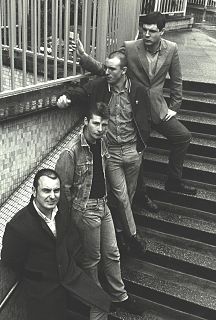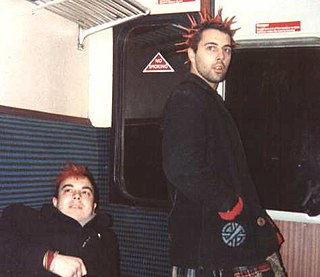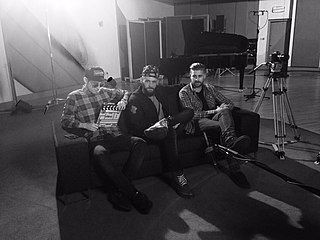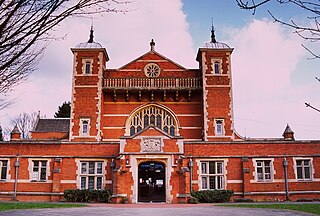Related Research Articles

Goth is a music-based subculture that began in the United Kingdom during the early 1980s. It was developed by fans of Gothic rock, an offshoot of the post-punk music genre. The name Goth was derived directly from the genre. Notable post-punk artists who presaged the Gothic rock genre and helped develop and shape the subculture include: Adam and the Ants, Siouxsie and the Banshees, Bauhaus, Lene Lovich, the Cure, and Joy Division.

The punk subculture includes a diverse and widely known array of ideologies, fashion, and other forms of expression, visual art, dance, literature and film. Largely characterised by anti-establishment views, the promotion of individual freedom, and the DIY ethics, the culture originated from punk rock.

A skinhead is a member of a subculture which originated among working class youths in London, England, in the 1960s and soon spread to other parts of the United Kingdom, with a second working class skinhead movement emerging worldwide in the late 1970s. Motivated by social alienation and working class solidarity, skinheads are defined by their close-cropped or shaven heads and working-class clothing such as Dr. Martens and steel toe work boots, braces, high rise and varying length straight-leg jeans, and button-down collar shirts, usually slim fitting in check or plain. The movement reached a peak at the end of the 1960s, experienced a revival in the 1980s, and, since then, has endured in multiple contexts worldwide.

Gothic fashion is a clothing style marked by dark, mysterious, antiquated, homogenous, and often genderless features. It is worn by members of the Goth subculture. Dress, typical gothic fashion includes dyed black hair, exotic hairstyles, dark lipstick and dark clothing. Both male and female goths can wear dark eyeliner, dark nail polish and lipstick for a dramatic effect. Male goths use cosmetics at a higher rate than other men. Styles are often borrowed from the punk fashion and can also draw influence from Victorians and Elizabethan fashion. Goth fashion is sometimes confused with heavy metal fashion and emo fashion.

Punk fashion is the clothing, hairstyles, cosmetics, jewellery, and body modifications of the punk counterculture. Punk fashion varies widely, ranging from Vivienne Westwood designs to styles modeled on bands like The Exploited to the dressed-down look of North American hardcore. The distinct social dress of other subcultures and art movements, including glam rock, skinheads, rude boys, greasers, and mods have influenced punk fashion. Punk fashion has likewise influenced the styles of these groups, as well as those of popular culture. Many punks use clothing as a way of making a statement.
Two-tone or 2 tone is a genre of British popular music of the late 1970s and early 1980s that fused traditional Jamaican ska music with elements of punk rock and new wave music. Its name derives from 2 Tone Records, a record label founded in 1979 by Jerry Dammers of The Specials, and references a desire to transcend and defuse racial tensions in Thatcher-era Britain: many two-tone groups, such as The Specials, The Selecter, and The Beat featured a mix of black, white, and multiracial people.

Skinheads Against Racial Prejudice (SHARP) are anti-racist skinheads who oppose white power skinheads, neo-fascists and other political racists, particularly if they identify themselves as skinheads. SHARPs aim to reclaim the original multicultural identity of the original skinheads, hijacked by white power skinheads, who they sometimes deride as "boneheads".
Rude boy, rudeboy, rudie, rudi, and rudy are slang terms that originated in 1960s Jamaican street culture, and that are still used today. In the late 1970s, there was a revival in England of the terms rude boy and rude girl, among other variations, being used to describe fans of two-tone ska. The use of these terms moved into the more contemporary ska punk movement as well. In the UK, the terms rude boy and rude girl are used in a way similar to gangsta, yardie or badman.

Leonard Hilton McGurr, known as Futura, and formerly known as Futura 2000, is an American graffiti artist.

The Fashion Institute of Technology (FIT) is a public college in New York City. It is part of the State University of New York (SUNY) and focuses on art, business, design, mass communication, and technology connected to the fashion industry. It was founded in 1944.

Interior design is the art and science of enhancing the interior of a building to achieve a healthier and more aesthetically pleasing environment for the people using the space. An interior designer is someone who plans, researches, coordinates, and manages such enhancement projects. Interior design is a multifaceted profession that includes conceptual development, space planning, site inspections, programming, research, communicating with the stakeholders of a project, construction management, and execution of the design.

Donovan "Don" Letts is a British film director, disc jockey (DJ) and musician. Letts first came to prominence as the videographer for the Clash, directing several of their music videos. In 1984, Letts co-founded the band Big Audio Dynamite with former Clash lead guitarist and co-lead vocalist Mick Jones, acting as the band's sampler and videographer before departing the band in 1990.

Fashion of the 1980s was characterized by a rejection of 1970s fashion. Punk fashion began as a reaction against both the hippie movement of the past decades and the materialist values of the current decade. The first half of the decade was relatively tame in comparison to the second half, which was when apparel became very bright and vivid in appearance.
Dean Chalkley is a British photographer from Southend-on-Sea.

The scene subculture is a youth subculture that emerged during the early 2000s in the United States from the pre-existing emo subculture. The subculture became popular with adolescents from the mid-2000s to early 2010s. Members of the scene subculture are referred to as scene kids, trendies, or scenesters. Scene fashion consists of skinny jeans, bright colored clothing, a signature hairstyle consisting of straight, flat hair with long fringes covering their forehead, and bright colored hair dye. Music genres associated with the scene subculture include metalcore, crunkcore, deathcore, electronic music, and pop punk.

Belinda Magnus, better known as Pauline Black, is an English singer, actress and author.

Toby Victor Mott is a British artist, designer, and sometime Punk historian known for his work with the Grey Organisation, an artists' collective that was active in the 1980s, and for his fashion brand Toby Pimlico. More recently he has become known for his Mott Collection, an archive of UK punk rock and political ephemera that includes over 1,000 posters, flyers, and fanzines.

The Original Rudeboys (O.R.B.) are an acoustic pop/hip hop band from Dublin. They are notable for their debut album This Life which was released in 2012 and debuted at number one on the Irish iTunes Charts, and their single "Stars in My Eyes", which hit number 2 on iTunes and received national airplay. They have played at venues such as the Olympia Theatre and at festivals such as Oxegen and the Reading and Leeds Festivals.

Harrow Arts Centre (HAC) is a professional arts venue in the London Borough of Harrow. HAC is located in Hatch End, Harrow, North London, in the Elliott Hall and other buildings that were previously part of the Royal Commercial Travellers School. It is the only dedicated performing arts venue in the borough.
Iain McKell is a British fashion, portrait and social documentary photographer. He has specialized in photographing British subcultures since the 1980s and his work has been published in L'uomo Vogue,i-D and The Face.
References
- ↑ "Return of the Rudeboy". www.somersethouse.org.uk. Somerset House. Retrieved 9 December 2014.
- ↑ "Return of the Rudeboy". Return of the Rudeboy Ltd. Retrieved 9 December 2014.
- ↑ Culture Clash: Dread Meets Punk Rockers. S. A. F. Publishing Limited. 1 May 2008. ISBN 0946719993.
- ↑ Black by Design: A 2-Tone Memoir. BlackProfile Books. 14 Jul 2011. p. 138. ISBN 1847657621.
- ↑ Asare-Boadu, Nana yaa. "The fashionable Mr Lambert". www.theguardian.com/. Guardian News and Media Limited. Retrieved 9 December 2014.
- ↑ Somerset House. "Return of the Rudeboy Storify Twitter Tour". storify.com. Storify. Retrieved 9 December 2014.
- ↑ "Return of the Rudeboy". www.returnoftherudeboy.com. Return of the Rudeboy Ltd. Retrieved 9 December 2014.
- ↑ "Return Of The Rudeboy' At London's Somerset House". www.okayafrica.com. okayafrica.com. Retrieved 9 December 2014.
- ↑ Premier: Return of the Rudeboy by Wonderland
- ↑ "#RudeboysReturn Twitter Tour". storify.com. Somerset House. Retrieved 9 December 2014.